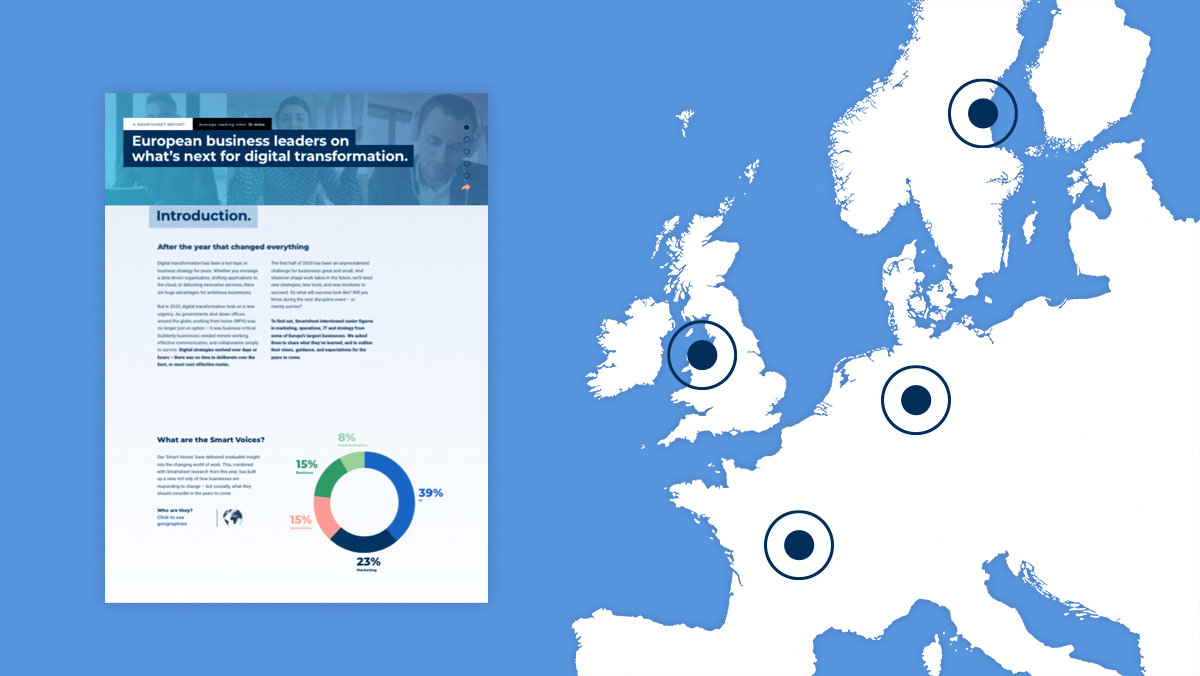Article
Accelerating transformation beyond 2020: the ambitions of European transformation leaders
From large-scale tech and infrastructure updates to sweeping cultural change, ambitious transformation leaders are no strangers to planning complex, lofty digital transformation projects – after all, it’s in the job description.
But when the COVID-19 pandemic hit, digital transformation projects were reprioritised, revisited, and retooled – with remote working and virtual communications (that is, the very foundations of effective work) at the top of the list.
For most, it seems like we’ve got those basics down – which is no small achievement. But what comes next, as transformation leaders lean back to thinking of a more ambitious picture? And what are their plans moving forward to help their organisations thrive in this new world?
At Smartsheet, we’ve interviewed European business leaders to find out how they’ve approached this challenge, and what they’ve learned. We call them Smart Voices – we’ll be seeing some of their insights later on.
You can read the full report right now to see what our Smart Voices said about the future of digital transformation and work: European business leaders on what’s next for digital transformation.
The future of remote working
With home working and virtual teamwork now essential, many businesses have found themselves making valuable attitudinal shifts.
A business Voice in telecoms explained:
“We had a lot of our store’s staff furloughed, and then actually... realised we could use them at call centres. We've taken them off furlough and, the majority of them, we’re actually using right now, to do business calls…”They emphasised that the priority was:
“Just thinking about flexibility and how you can work with your teams harder and differently."
So now it’s time to consolidate, integrate what’s been learned so far, and think about how to make recent changes really work. Transformation and business leaders alike have established they can keep virtual teams and remote workers communicating. Now, it’s time to start enabling real collaboration and finding ways to improve productivity.
Transformation leaders should think about how they can support resilience within the organisation by finding solutions that make collaboration possible without returning to communication overload.
As one transformation Voice observed:
"It's much more work [to facilitate and organise meetings] in a virtual environment than in real life. Because the preparation, which is always, in my opinion, key to the success of meetings, has to be given more thought... I told the guys, don't forget everything we agree upon [in] a meeting, we have to follow up on this. And if you have the next meeting after that, and the next and the next, you cannot do it. If we have less meetings, then we are getting more productive.”
So transformation leaders need to think about how they can help those on the front line connect in new ways.
But in addition to accommodating these present needs, transformation leaders should be the ones looking to the future. Because while there’s no going back to the way things were, there’s a very real opportunity to build a new and better world of work.
For example, some transformation leaders are already thinking hard about leveraging the possibilities of virtual reality.
As a transformation Voice in automotive said:
“We are working on developing new concepts to make use of digital tools so that we can have whole change management or transformation processes facilitated in a virtual environment. From Microsoft Teams up to thinking about virtual reality.”
A culture for ongoing transformation
So – how can leaders ensure they have the right culture for innovative transformation, given many will be remote or hybrid working for the long haul?
Our transformation Voice in automotive reflected that:
“...the biggest challenge in transformation... is how to give [people] a perspective and a purpose to work on, and how to find out what qualifications and competencies we need in the future. And how can we make use of the workforce that we have?”
Getting everyone ‘pulling together’ is essential for successfully delivering change. And it’s the best way to ensure a common sense of purpose, as well as clarifying which skillsets and competencies are needed most. That makes collaboration key.
But ensuring everyone collaborates using the same tools is part of this. Once there are a smaller number of standard solutions across the organisation, transformation leaders can start thinking about how to integrate these into their previous plans. Or adapt their old plans to fit the new working landscape. Either way, a specialist solution for collaboration and work management is a valuable part of the mix.
Looking to the future of change
For more thoughts on the future of work from Smart Voices working in transformation and other business areas, download our full report: European business leaders on what’s next for digital transformation.

